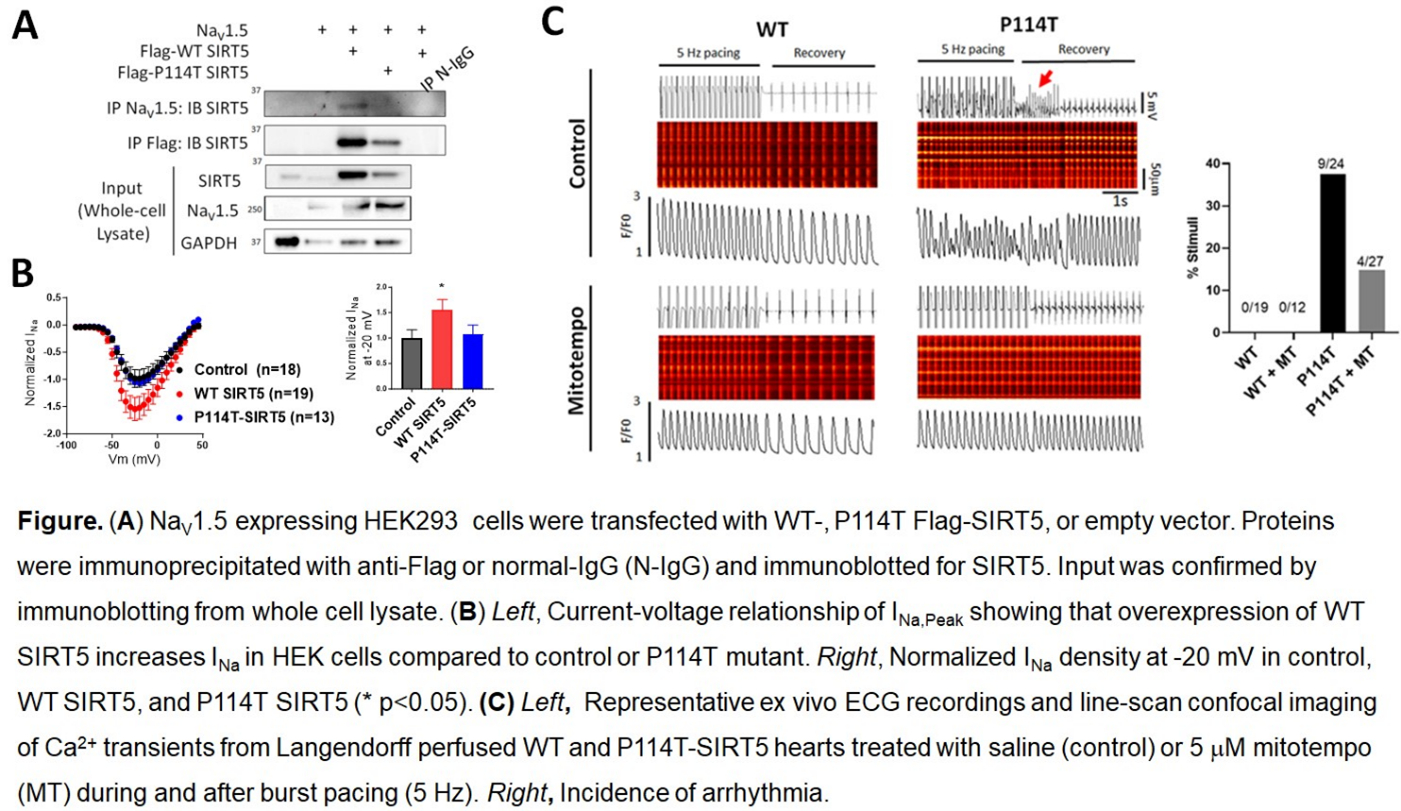Final ID: MDP1259
SIRTUIN5 Modulates Na+/Ca2+ Handling Via Oxidative Stress Dependent Manner In Mouse Heart
Abstract Body (Do not enter title and authors here):
Background: The cardiac Na+ channel NaV1.5 (encoded by SCN5A) governs cardiac inward Na+ current (INa) and the fast upstroke and plateau phases of the cardiac action potential. Mutations in NaV1.5 can cause acquired or inherited arrhythmias and conduction diseases, including ~20% of cases of Brugada Syndrome (BrS). Changes in INa can impact Ca2+ handling and cardiac excitation-contraction coupling. We have previously shown that SIRT1-mediated deacetylation of NaV1.5 increased INa. Recently, potential mutations (including P114T) in SIRT5, another NAD+-dependent deACYLase in the Sirtuin family localized to mitochondria, were identified in small families with BrS.
Hypothesis: Sirt5 dysfunction evokes arrhythmias via Na+ and Ca2+ mishandling in an oxidative stress-dependent manner in mouse hearts.
Aims: To explore the potential role of SIRT5 in BrS using heterologous expression systems and homozygous P114T-Sirt5 knock-in (P114T-KI) mice.
Methods: Protein expression and physical interactions were detected by immunoprecipitation and immunoblot. The effects of SIRT5 on Na+ current was measured using patch clamp in HEK cells and mouse cardiac myocytes. Confocal microscopy was used to measure reactive oxygen species (ROS) and for Ca2+ imaging.
Results: Both WT and P114T-SIRT5 co-immunoprecipitate with NaV1.5, but WT increased peak INa in HEK cells while P114T did not (Fig A,B). Live-cell staining using DCFDA or mitoSOX showed that P114T-KI hearts had increased basal ROS and were more sensitive to oxidative stress induced by H2O2 than WT littermates. P114T-KI hearts had increased Na+/Ca2+ exchange protein 1 (NCX1) expression, and Langendorff-perfused hearts displayed abnormal Ca2+ handling and arrhythmias (Fig C). Notably, treatment with the mitochondrial ROS scavenger mitotempo mitigated the aberrant Ca2+ handling and arrhythmias.
Conclusion: These findings suggest that the P114T-SIRT5 causes abnormal Na+ and Ca2+ handling and arrhythmias in a ROS-dependent manner, highlighting potential mechanisms underlying BrS. This finding may pave the way for the use of SIRT5 or its activators as novel anti-arrhythmic therapies in the future.
Background: The cardiac Na+ channel NaV1.5 (encoded by SCN5A) governs cardiac inward Na+ current (INa) and the fast upstroke and plateau phases of the cardiac action potential. Mutations in NaV1.5 can cause acquired or inherited arrhythmias and conduction diseases, including ~20% of cases of Brugada Syndrome (BrS). Changes in INa can impact Ca2+ handling and cardiac excitation-contraction coupling. We have previously shown that SIRT1-mediated deacetylation of NaV1.5 increased INa. Recently, potential mutations (including P114T) in SIRT5, another NAD+-dependent deACYLase in the Sirtuin family localized to mitochondria, were identified in small families with BrS.
Hypothesis: Sirt5 dysfunction evokes arrhythmias via Na+ and Ca2+ mishandling in an oxidative stress-dependent manner in mouse hearts.
Aims: To explore the potential role of SIRT5 in BrS using heterologous expression systems and homozygous P114T-Sirt5 knock-in (P114T-KI) mice.
Methods: Protein expression and physical interactions were detected by immunoprecipitation and immunoblot. The effects of SIRT5 on Na+ current was measured using patch clamp in HEK cells and mouse cardiac myocytes. Confocal microscopy was used to measure reactive oxygen species (ROS) and for Ca2+ imaging.
Results: Both WT and P114T-SIRT5 co-immunoprecipitate with NaV1.5, but WT increased peak INa in HEK cells while P114T did not (Fig A,B). Live-cell staining using DCFDA or mitoSOX showed that P114T-KI hearts had increased basal ROS and were more sensitive to oxidative stress induced by H2O2 than WT littermates. P114T-KI hearts had increased Na+/Ca2+ exchange protein 1 (NCX1) expression, and Langendorff-perfused hearts displayed abnormal Ca2+ handling and arrhythmias (Fig C). Notably, treatment with the mitochondrial ROS scavenger mitotempo mitigated the aberrant Ca2+ handling and arrhythmias.
Conclusion: These findings suggest that the P114T-SIRT5 causes abnormal Na+ and Ca2+ handling and arrhythmias in a ROS-dependent manner, highlighting potential mechanisms underlying BrS. This finding may pave the way for the use of SIRT5 or its activators as novel anti-arrhythmic therapies in the future.
More abstracts on this topic:
A Bifunctional Actuator Reverses NaV1.5 Dysfunction Linked To Cardiac Arrhythmias
Fossier Lucile, Yehya Marc, Mahling Ryan, Gabelli Sandra, Colecraft Henry, Ben Johny Manu
A Case Series of Papillary Fibroelastomas on the Coumadin ridgeAboukhatwa Omar, Akiki Elias, Kurmann Reto, Larson Kathryn, Keeney Michael, Bois Melanie, Klarich Kyle

